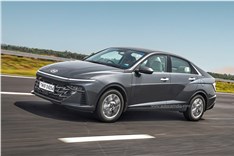2017 Hyundai Verna review, test drive
We get behind the wheel of the all-new next generation Hyundai Verna and find out how much of a leap it is over its predecessor.
Published on Aug 25, 2017 06:27:00 PM
1,16,482 Views
Follow us on



What is it?
The fluidic Verna, with its snazzy styling and list of features, was really welcomed with open arms by buyers and it actually went on to dominate its segment for a pretty long time. However, with the introduction of the more comfortable and more spacious new-generation Honda City and the all-new Maruti Ciaz, the Verna was sidelined. Hyundai wasn’t just going to give up without a fight and now, six years after the launch of the previous generation model, the company has pumped in Rs 1,000 crore to bring us this – the fifth-generation Verna. Priced at a rather attractive Rs 7.99-12.24 lakh for the petrol and Rs 9.20-12.62 lakh for the diesel (both, ex-showroom, Delhi), the Verna is back to grab a chunky slice of the segment that has long eluded it.
Built on an all-new K2 platform, it’s more rigid than before and uses a greater percentage of high-strength steel. At first glance, this new car can easily be mistaken for the more premium Hyundai Elantra. Even the car’s silhouette is more like the Elantra than the previous-generation Verna. The chrome-lined ‘cascading’ grille (like the Xcent’s) dominates the face, with the swept-back projector headlamps adding some definition. It also gets integrated daytime running lights (DRLs) which turn off when the handbrake is engaged, like in the Xcent and Grand i10. New and segment-first projector fog lamps are housed by chrome-lined pentagons that look a bit quirky. However, the rest of the exterior design has soft character lines and the design is a lot more contemporary and very European, and will have a universal appeal. The chrome door handles, chrome window belt line, the 16-inch diamond-cut wheels and its coupe-like sloping roof lend a classy touch to the side profile. However, the rear bumper looks a bit bulky, especially from the side, making the wheel appear a bit small. The unique black plastic accent on the lower half of the rear bumper does help break its bulk to an extent, at least when viewed head on. Its new stretched tail-lights make the car appear wider than it actually is and includes striking LED elements. This new Verna has grown in dimensions but doesn’t appear as large as the Ciaz or the City; instead, due to its balanced proportions, it looks well-rounded.
What is it like inside?
Get inside and there’s an air of familiarity. Sure, the dashboard design is all-new but it feels like a mixture of several design cues borrowed from cars like the Creta, the Elantra and the Elite i20. There’s a lot of switchgear that’s carried over from these cars and, while the quality and fit-finish of parts and materials are second to none, these interiors just don’t feel as special as what we’ve come to expect out of all new-generation Hyundai cars. Also, there are a few buttons like those for the air con and the engine start-stop button that feel fiddly and a bit downmarket, not something you expect in a modern Hyundai. The layout and design, however, is practical and there are many well-shaped storage areas, including a large, cooled glovebox.
The front seats are supportive and draped in well-finished artificial leather. Look closely and you’ll see perforations in the seats which are meant to throw out cool air; this is the superb seat ventilation function that’s made its way to the Verna from the Elantra, and is a real boon for a climate like ours.
| Hyundai Verna Price, Mileage, Specifications, Features and Variants | |
|---|---|
| Brand | Hyundai |
| Model Name | Verna |
| Hyundai Verna Price | ₹ 12.86 - 20.27 lakh |
| Hyundai Verna Range/Mileage | Petrol : 18.6 - 20.6kpl |
| Hyundai Verna Specifications | Sedan | 5 doors | 5 seats View All Specs |
| Hyundai Verna Features | LED headlight | 10.25-inch Touchscreen display | 6 airbags View All Features |
| Hyundai Verna Variants | 1.5 Petrol EX MT | 1.5 Petrol S MT | 1.5 Petrol SX MT View All Variants |
The Verna still has a low stance, so getting to the back seat isn’t very convenient. Also, even though the rear seat is supportive and cushioning is nice, it’s placed a bit on the lower side, which means that taller passengers will be sitting in a slightly knees-up position. Even headroom at the rear is in short supply due to the sloping roofline and thick headliner (to accommodate the sunroof) which eats into vertical space. The backseat experience, especially in terms of space and comfort, isn’t at par with the Honda City or the Maruti Ciaz but Hyundai has tried to compensate without stinting on features. You get rear air con vents, a manual sunblind on the rear windscreen, Isofix child seat mounts and even adjustable neck restraints. Another positive is that boot capacity has increased by 20 litres and now stands at 480 litres.
The new electric sunroof floods the cabin with light but is only available on the SX (O) and SX+ (diesel auto) variant. Speaking of which, this new car is extremely well-equipped. Then, there’s the familiar 7.0-inch touchscreen infotainment system that’s responsive and easy to operate. It gets Android Auto, Apple CarPlay, and even features voice commands that are linked to your smartphone, which work seamlessly. The Arkamys sound mood actually improves the audio experience from the speakers. A welcome move by Hyundai is to retain the six airbags in the top SX (O) variant. Other goodies like cruise control, hands-free boot opening, auto headlamps and auto dimming mirror also make it to the equipment list, but, curiously, telescopic steering adjustment and rain-sensing wipers don’t.
Another new, segment-first feature that the top-spec Verna gets is something called Hyundai Auto Link; here, the car gets a Bluetooth dongle that connects to an app on the driver's smartphone and displays live telemetry such as engine rpm, vehicle speed and even engine load. It also tracks distance travelled, time taken for each driving session and overlays it on a map to show you your driving route. But the most interesting thing it records is the number of times the driver braked or accelerated suddenly! It simplifies all these driving parameters into an efficiency score represented by five bars. The more of these you can keep green, the more efficiently you're driving. How cool is that?
What’s it like to drive?
Hyundai has dropped the 1.4-litre engine options from the range and the Verna only gets the 1.6-litre petrol and diesel engine, with a few tweaks. Also, both these engines come with the option of six-speed manual or automatic transmissions, carried over from the Creta, which replace the four-speed automatics, and five-speed manual for the petrol of the outgoing car.
The diesel remains the familiar 128hp, 1,582cc four-cylinder engine churning 260Nm of torque. While the power and torque rating are identical to the outgoing car, with a few tweaks, this engine produces max torque across a wider band of 1,500-3,000rpm now (compared to 1,900-2,750rpm). What’s immediately noticeable is how silent this motor is at idling speeds. However, get moving and there’s a prominent diesel clatter that creeps in on large throttle openings. This disappears once you ease off the throttle pedal, and this engine is definitely quieter than the competition. This engine is very driveable too, thanks to a linear power delivery. From as low as 1,200rpm, the motor pulls very nicely right from the word go without any perceivable lag and builds up speed in a seamless fashion. In fact, it feels like a naturally aspirated petrol in this regard, with sharp throttle responses. This 1.6 has meaty performance at mid revs too and overtaking feels effortless. Even though the tacho needle is willing to rev freely, there’s no point in revving it till the 5,000rpm redline, as progress beyond 4,200rpm becomes slow.
The 1.6 litre petrol motor is amazingly smooth right off the bat and you can barely even hear or feel it at idle. This 1,591cc naturally aspirated four-cylinder motor makes 123hp and 151Nm of peak torque, which is about 4Nm less than from the same engine in the outgoing Verna. However, there's much more torque available lower down in the rev range, which has done wonders for the motor's tractability. Sure, it doesn't have the same punch as the diesel motor, but it can smoothly pull away in fifth gear from as low as 30-35kph. Slot the gearbox into sixth at 50kph and the motor will sit happily, ambling away at about 1,250rpm. To build a bit of speed, the engine needs to be revved quite hard. Now this isn't a particularly free-revving motor, but as the rpm climbs, the dual variable valve timing system (which Hyundai refers to as VTVT) really comes into play and the engines pull is noticeably high past 4,000rpm. So with a bit of downshifting and firewalling the throttle pedal, it is possible to have a bit of fun with the petrol Verna.
Those opting for the six-speed manual gearbox will love how smooth and precise this unit’s shifts are. Even the clutch is pretty light, although it has a rather aggressive, springy action. The diesel automatic, on the other hand, is a bit lazy and gearshifts aren’t particularly quick, like the twin-clutch DSG unit in the diesel Rapid and Vento. Still, it is smooth, refined and does the job of everyday commuting. Again, the Verna diesel auto feels effortless to drive, thanks to generous torque and an engine that feels like it has a surplus of power.
The brakes are nice and even though it doesn’t get rear discs anymore, it stops without any fuss from high speeds and the pedal feel is reassuring. Handling has always been a point of contention in the old Verna and, thankfully, Hyundai has worked really hard to fix this with the new car. A completely revised steering geometry and a stiffer chassis have gone a long way to address these handling woes, resulting in the new car being significantly better to drive than the previous one. The electrically assisted power steering still doesn't provide any real feedback though and has a strange dead zone around the straight ahead position. However, once you pile on the lock or turn off-centre, the steering feels much better, weighing up in a linear and predictable manner. Driving briskly up the twisting mountain road outside Kochi on our first drive, it was very easy to get the Verna to point in the exact direction we wanted to; though, the lack of any real feedback from the steering made the whole feeling akin to playing a video game. As much fun as we had, the new Verna still felt like a slightly soft car and the way it went around bends or managed body roll was far from sporty. But this really shouldn't be a concern for regular use and everyone who's driven the previous car is sure to appreciate just how much nicer this one feels from behind the wheel.
What’s nice is that this car’s ride in the city feels great. It soaks up the bumps and potholes really competently, with only muted thuds filtering in on the sharper ones. Even vertical movements are minimal and it recovers very well after hitting a pothole. It doesn’t keep bobbing at highway speeds or over wavy surfaces, and this new chassis feels tighter and better-controlled over uneven surfaces than before.
Should I buy one?
This all-new Verna is a confident step up from the older generation. The ride and handling is a good improvement over the updated 2015 car and there are six-speed manual and auto transmissions which make this car a better cruiser than before. The new interiors are a bit more spacious and the boot is a bit larger too. Its baby-Elantra looks, and an equipment list that matches its Rs 20-lakh sibling, will definitely be a big draw for buyers.
However, what works against it is that it just doesn’t seem as revolutionary as what we’ve come to expect out of new-generation Hyundai cars. Even the interiors, although high quality, just don’t feel a big step forward. Then, the fact that rear seat comfort isn’t up there with the best, might dissuade the chauffeur-driven lot.
Spec to spec, this new Verna offers a lot more than its competition and is priced rather competitively too, undercutting the Honda City by a big margin. It doesn’t beat the Maruti Ciaz in terms of price and neither is it as nice to drive as the Vento or the Rapid; but, for someone who wants a comfortable and effortless driving experience in a feature-loaded, contemporary package, Hyundai’s new mid-size sedan makes for a very compelling proposition.
Tech Specs 
Copyright (c) Autocar India. All rights reserved.




.jpg&w=234&h=156&q=90&c=1)


 Price
Price Engine
Engine Transmission
Transmission Efficiency
Efficiency Dimensions
Dimensions
Comments
Member Login
Personal Details
No comments yet. Be the first to comment.